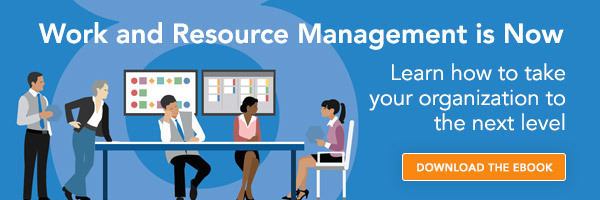
For part three of this blog series based on the Ventana Research whitepaper, “Five Ways to Increase Efficiency and Innovate Faster,” I will discuss a three simple ways to assess the current state of your organization and begin thinking about how to adopt more modern ways of working. Before we get started, be sure and check out the first two blogs in this series:
- “What is Work and Resource Management: Part 1 – Adapting to change,” and
- “Overcome Hurdles to Maximize Business Value: Part 2 – Advance the business with work and resource management.”
Chances are your organization is currently operating using disparate systems, particularly spreadsheets, or has done so in the past. This approach to managing work and resources, albeit common, is actually a hindrance to efficiency, as it can increase complexity. If this approach applies to your organization, I’m willing to bet it has led to many headaches, both in regards to communication and adjusting plans based on market changes or internal shifts.
Adopting a systematic approach to managing work and resources will not only enhance your ability to meet organizational goals, enhance communication, and improve productivity, but will equip your organization with a powerful competitive advantage. Why? According to Ventana Research, only 14% of organizations state they effectively manage project plans “very well,” leaving you with plenty of room to stand out from your competition by introducing innovative products to the market faster or deploying projects and applications internally that improve overall business efficiency.
Before jumping in and adopting a new solution, begin by assessing the current state of your organization, and adjust where necessary. This will not only simplify the transition to better processes but will also help identify specific requirements needed to justify the cost of investing in dedicated software. Follow these three simple steps from Ventana Research to get started:
- Assess current processes.
Identify and outline processes including:- Responsiveness of the organization and the ability to adapt to change;
- Collaboration across teams and visibility into the impact of work completed; and
- Utilization of all resources through prioritization, tracking, and productivity.
- Minimize complexity by taking an inventory.
Start an inventory. Understand where information is hosted. Is it accurate data? Is it located in a home-grown reporting platform, an outdated application, or are you using spreadsheets? By taking inventory of what you have and what you need will not only allow you to understand where the gaps are, but it will help you identify what information can be consolidated, eliminated, or improved upon – helping you to further refine your requirements and on your way adopting solutions that support the business. - Align work and resources across departmental boundaries. Support digital initiatives and work to improve communication between departments. How are teams communicating now? Is it effective? How much time is wasted? Consider an approach that allows people to work in the tools they are most comfortable in to get the job done – and at the same time, break down silos to improve collaboration.
By working through these 3 steps, your organization will be better prepared to not only understand current state, but help you evaluate where you need to be. For more information, download the Ventana Research whitepaper, be sure to check out the remaining blogs in this series, listed below:
- Advantages of Work and Resource Management Applications: Part 4 – All for one and one for all;
- Work and Resource Management: Benefits to Bypass the Competition: Part 5 – Boost your organization with the benefits of WRM; and
- How to Get Started with Work and Resource Management: Part 6 – 5 simple steps to minimize costs and maximize efficiency.





